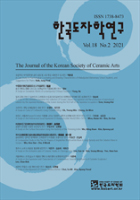자연미(自然美)라는 것은 자연과 현실의 각종 대상에서 나타난 아름다움을 가리킨다. 예를 들면 사계절이 변화, 자연의 동·식물, 해변의 파도와 구름의 변화등 여려가지를 들 수 있다. 도자기 예술에서자연 요소를 사용하는 것은 중요한 표현 기법중의 하나이다. 자연 요소를 사용하여 도자기 작품을 자연에 더 가깝고 자연과 생명에 대한 사람들의 인식을 심화시키는 동시에 도자기 작품의 표현력과 함의를 풍부하게 할 수 있다. 본 연구에서는 중국의 이싱(宜興) 자사호를 중심으로 명나라(1368-1644), 청나라(1723-1795), 민국(1912-1949), 그리고 현대의 일부 자사호 작품에 이르기까지 자사호의 형태를 분석하고 그 디자인에 사용된 자연미를 연구 하였다. 그 중 근문기(筋紋器)는 명나라 자사호 조형의 주류로 꽃잎, 참외, 능화(菱花), 등을 자사호 조형에도입하여 자연의 재미를 더한 것이 특징이다. 청나라의 초기 자사호는 화려한 스타일이 많았으며 나중에는 단순한 스타일로 변했다. 자사호 몸체는 선이 단순하고 자연스러우며 시, 회화 등의 장식이 있다. 민국시대에는 자사호의 수요가 증가하여 장인(匠人)들의 작품이 많이 생산되었다. 현대에 들어와 자주호의 모양이 다양해졌고, 여전히 자연에서 볼 수 있는 소나무·대나무·꽃·호박·잎 등을 주제로 하고 있지만, 자주호의 디자인 감각이 더욱 강해져 작가들은 자사토양의 특성을 이용하여 작품을 만드는데 더 능숙해졌으며, 동시에 현대 작품의 개인적 특색이 더욱 뚜렷하게 나타났다. 이 연구는 자사호 디자인의 자연적 요소를 분석하고 이것이 향후 이싱 도자기의 미래에 많은 디자인 발전을 가져올 수 있음을 탐구할 것이다.
Natural beauty is the beauty that appears in various objects of nature and reality. Examples include the changes of the seasons, natural animals and plants, waves on the seashore and clouds. In ceramic art, the use of natural elements is an extremely important expressive technique. The use of natural elements can bring ceramic works closer to nature, allowing people to have a deeper knowledge of nature and life, and also enriching the expressiveness and connotation of ceramic works. This seminar focuses on Chinese Yixing Zisha pots, analyzing and outlining the characteristics of Zisha clay and explaining its development. By analyzing and categorizing the types of zisha pots, we will sort out and analyze some of the works of zisha pots from the Ming Dynasty (1368-1644), Qing Dynasty (172-1795), Republic of China (1912-1949), and even modern times, to find out the essence of their design and observe the natural beauty contained in the works. The factors that determine the shape of Zisha pots are analyzed and refined from the typical shapes of Zisha pots in various historical eras. Among them, the ribbed ware is the mainstream of the Ming Dynasty Zisha pot modeling, and its modeling is characterized by the introduction of petals, melons, diamonds, and other forms into the Zisha pot modeling, increasing the natural interest. Qing dynasty purple sand before the popularity of rich and luxurious style, after the complexity into simplicity. The lines of the pots were simple and natural, decorated with poems and paintings. During the Republic of China period, because of the developed export industry of Zisha pots, there were many excellent artists born in this period, such as Feng Guilin, Li Baozhen etc. After entering the modern era, the shape of Zisha pots became diversified, although still based on the theme of pines, bamboos, flowers, pumpkins, leaves, etc., which can be seen in nature, the design of Zisha pots became stronger, and writers became more adept at utilizing the characteristics of Zisha clay to create their works, and at the same time, found that the individuality of their works in the modern era was more obvious. This study will analyze the elements of nature in the design of Zisha tea sets and explore the many design developments this will bring to the future of Yixing ceramics.
Ⅰ. 서론
Ⅱ. .중국 이싱 자사호의 특징 및 자연미
Ⅲ. 이싱 자사호의 발전 특징 분석
Ⅳ. 결론
참고문헌
